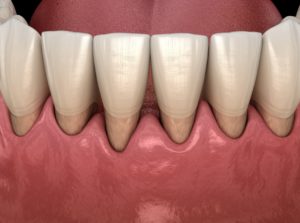 Your gum health is equally important as your teeth. Unfortunately, you can lose gum tissue for various reasons, like an infection, aggressive brushing habits, or trauma. If there isn’t enough tissue to cover the tooth roots, you may need gum grafting. It can be included in gum disease therapy for patients with advanced stages of the infection. If your dentist has recommended gum grafting, you don’t need to be concerned about a painful procedure. Here’s what you can expect while on the road to a healthy smile.
Your gum health is equally important as your teeth. Unfortunately, you can lose gum tissue for various reasons, like an infection, aggressive brushing habits, or trauma. If there isn’t enough tissue to cover the tooth roots, you may need gum grafting. It can be included in gum disease therapy for patients with advanced stages of the infection. If your dentist has recommended gum grafting, you don’t need to be concerned about a painful procedure. Here’s what you can expect while on the road to a healthy smile.
Who Needs Gum Grafting?
Gum grafting is recommended for patients who have exposed tooth roots, which can result from aggressive brushing habits or a hard-bristled toothbrush. Often, patients with advanced gum disease require grafting to repair damage caused by the infection. Without restoring the gum tissue, it can cause bone and tooth loss. Gum grafting restores a healthy gum line and covers the roots to protect them from bacteria.
What is Gum Grafting?
Gum grafting is a minor surgical procedure used to restore a healthy, attractive gum line. An anesthetic will be used to keep you comfortable while a small piece of tissue is grafted onto the treatment area. Your dentist will use tissue from the roof of your mouth or a donor to stitch over the exposed root.
Although you won’t have any discomfort, it’s normal for your gums to be a little tender for a few days. Don’t worry, your dentist will explain your aftercare instructions to keep you comfortable while your mouth heals.
Recovering from Gum Grafting
Thanks to new techniques and technologies, pain after gum grafting surgery is minimal, especially if you follow a few aftercare instructions, including:
- Control any bleeding by placing gauze on either side of the surgery location, but don’t put it directly on top of the healing tissue.
- Avoid strenuous physical activity for at least 24 hours to prevent pain and inflammation.
- Avoid hot, cold, or acidic foods and drinks for a few days.
- Eat softer foods for the first week. Introduce your regular diet gradually, but avoid chips, taco shells, and other hard foods that can affect healing.
- Rinse your mouth with water the day of the surgery, but don’t brush your teeth.
- After you’ve been given the go-ahead to resume brushing, don’t brush near the graft for one month.
- Rinse with salt water to keep your mouth clean by removing anything left behind by your toothbrush. It will also reduce pain and inflammation.
- Take an OTC pain reliever to manage your discomfort.
- Maintain any follow-up appointments with your dentist.
In a couple of weeks, you’ll be recovered from your grafting procedure. You’ll enjoy lasting results for a healthy, beautiful smile you’ll be proud to share with the world.
About Dr. John-Michael Stewart
Dr. Stewart earned his dental degree from Boston University before continuing his education in oral surgery, dental implants, and many other advanced specialties. He combines the art and science of dentistry to deliver high-quality care. If you have advanced periodontal disease, contact our office today to request your consultation.

